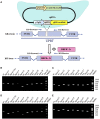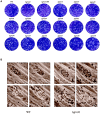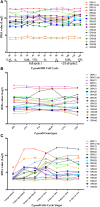Functional Characterization of Dense Granule Proteins in Toxoplasma gondii RH Strain Using CRISPR-Cas9 System
- PMID: 30211128
- PMCID: PMC6121064
- DOI: 10.3389/fcimb.2018.00300
Functional Characterization of Dense Granule Proteins in Toxoplasma gondii RH Strain Using CRISPR-Cas9 System
Abstract
Infection with the apicomplexan protozoan parasite Toxoplasma gondii is an ongoing public health problem. The parasite's ability to invade and replicate within the host cell is dependent on many effectors, such as dense granule proteins (GRAs) released from the specialized organelle dense granules, into host cells. GRAs have emerged as important determinants of T. gondii pathogenesis. However, the functions of some GRAs remain undefined. In this study, we used CRISPR-Cas9 technique to disrupt 17 GRA genes (GRA11, GRA12 bis, GRA13, GRA14, GRA20, GRA21, GRA28-31, GRA33-38, and GRA40) in the virulent T. gondii RH strain. The CRISPR-Cas9 constructs abolished the expression of the 17 GRA genes. Functional characterization of single ΔGRA mutants was achieved in vitro using cell-based plaque assay and egress assay, and in vivo in BALB/c mice. Targeted deletion of these 17 GRA genes had no significant effect neither on the in vitro growth and egress of the mutant strains from the host cells nor on the parasite virulence in the mouse model of infection. Comparative analysis of the transcriptomics data of the 17 GRA genes suggest that GRAs may serve different functions in different genotypes and life cycle stages of the parasite. In sum, although these 17 GRAs might not be essential for RH strain growth in vitro or virulence in mice, they may have roles in other strains or parasite stages, which warrants further investigations.
Keywords: CRISPR-Cas9; Toxoplasma gondii; dense granule proteins (GRAs); host-pathogen interaction; virulence.
Figures




Similar articles
-
Functional Characterization of 15 Novel Dense Granule Proteins in Toxoplasma gondii Using the CRISPR-Cas9 System.Microbiol Spectr. 2023 Feb 14;11(1):e0307822. doi: 10.1128/spectrum.03078-22. Epub 2022 Dec 14. Microbiol Spectr. 2023. PMID: 36515555 Free PMC article.
-
Effect of deletion of gra17 and gra23 genes on the growth, virulence, and immunogenicity of type II Toxoplasma gondii.Parasitol Res. 2020 Sep;119(9):2907-2916. doi: 10.1007/s00436-020-06815-z. Epub 2020 Jul 20. Parasitol Res. 2020. PMID: 32686022
-
Characterization of strain-specific phenotypes associated with knockout of dense granule protein 9 in Toxoplasma gondii.Mol Biochem Parasitol. 2019 Apr;229:53-61. doi: 10.1016/j.molbiopara.2019.01.003. Epub 2019 Mar 5. Mol Biochem Parasitol. 2019. PMID: 30849416
-
Recent advances in identifying and characterizing secretory proteins of Toxoplasma gondii by CRISPR-based screening.Parasitol Int. 2025 Apr;105:102997. doi: 10.1016/j.parint.2024.102997. Epub 2024 Nov 23. Parasitol Int. 2025. PMID: 39586398 Review.
-
GRA proteins of Toxoplasma gondii: maintenance of host-parasite interactions across the parasitophorous vacuolar membrane.Korean J Parasitol. 2009 Oct;47 Suppl(Suppl):S29-37. doi: 10.3347/kjp.2009.47.S.S29. Korean J Parasitol. 2009. PMID: 19885333 Free PMC article. Review.
Cited by
-
Timing of dense granule biogenesis in asexual malaria parasites.Microbiology (Reading). 2023 Aug;169(8):001389. doi: 10.1099/mic.0.001389. Microbiology (Reading). 2023. PMID: 37647112 Free PMC article.
-
Regulation of phosphoinositide metabolism in Apicomplexan parasites.Front Cell Dev Biol. 2023 Sep 15;11:1163574. doi: 10.3389/fcell.2023.1163574. eCollection 2023. Front Cell Dev Biol. 2023. PMID: 37791074 Free PMC article. Review.
-
ToxoNet: A high confidence map of protein-protein interactions in Toxoplasma gondii.PLoS Comput Biol. 2024 Jun 20;20(6):e1012208. doi: 10.1371/journal.pcbi.1012208. eCollection 2024 Jun. PLoS Comput Biol. 2024. PMID: 38900844 Free PMC article.
-
Platelet-Rich Plasma in Dermatology: New Insights on the Cellular Mechanism of Skin Repair and Regeneration.Life (Basel). 2023 Dec 25;14(1):40. doi: 10.3390/life14010040. Life (Basel). 2023. PMID: 38255655 Free PMC article. Review.
-
Functional Characterization of 15 Novel Dense Granule Proteins in Toxoplasma gondii Using the CRISPR-Cas9 System.Microbiol Spectr. 2023 Feb 14;11(1):e0307822. doi: 10.1128/spectrum.03078-22. Epub 2022 Dec 14. Microbiol Spectr. 2023. PMID: 36515555 Free PMC article.
References
-
- Bougdour A., Durandau E., Brenier-Pinchart M. P., Ortet P., Barakat M., Kieffer S., et al. . (2013). Host cell subversion by Toxoplasma GRA16, an exported dense granule protein that targets the host cell nucleus and alters gene expression. Cell. Host. Microbe 13, 489–500. 10.1016/j.chom.2013.03.002 - DOI - PubMed
Publication types
MeSH terms
Substances
LinkOut - more resources
Full Text Sources
Other Literature Sources
Miscellaneous

